北师大版(2019)必修 第三册Unit 7 Art Lesson 3 A Musical Genius名师教学设计
文档属性
| 名称 | 北师大版(2019)必修 第三册Unit 7 Art Lesson 3 A Musical Genius名师教学设计 | 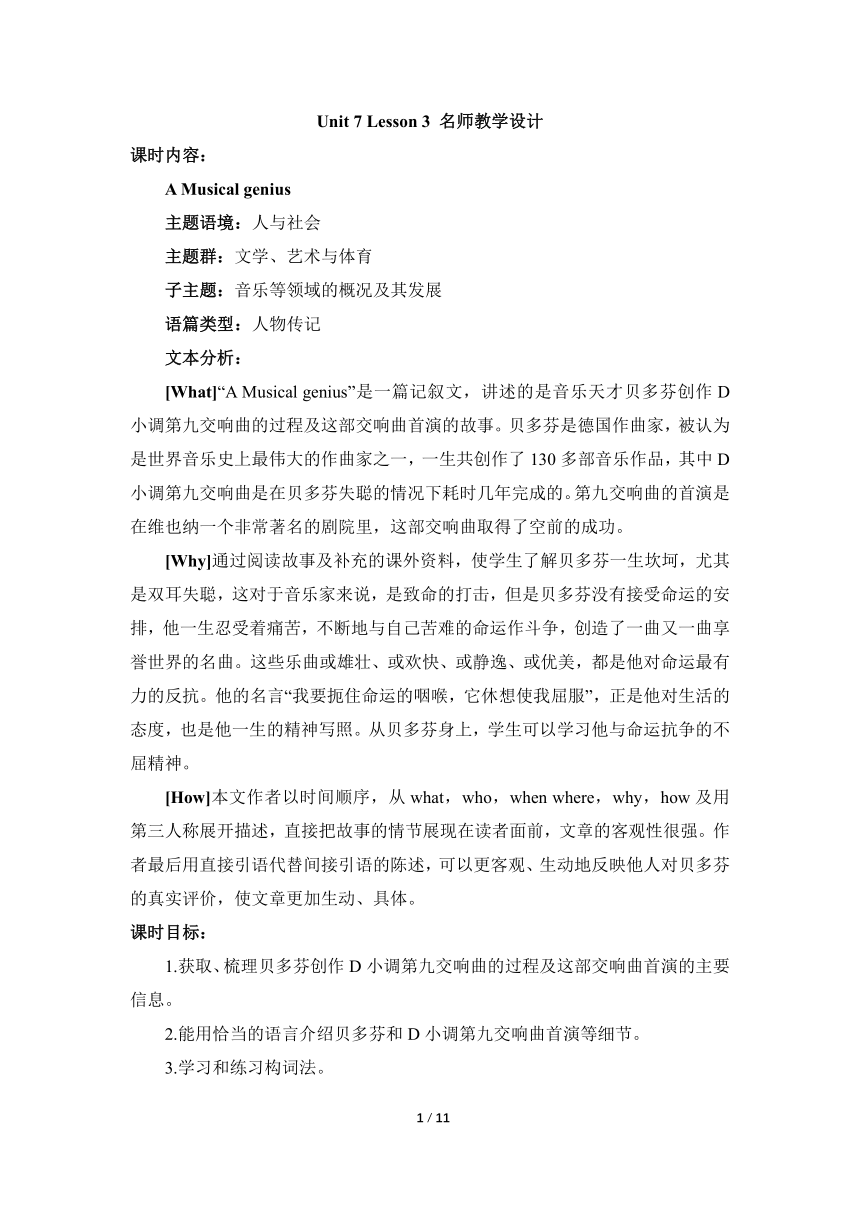 | |
| 格式 | docx | ||
| 文件大小 | 219.7KB | ||
| 资源类型 | 教案 | ||
| 版本资源 | 北师大版(2019) | ||
| 科目 | 英语 | ||
| 更新时间 | 2023-03-07 21:15:14 | ||
图片预览

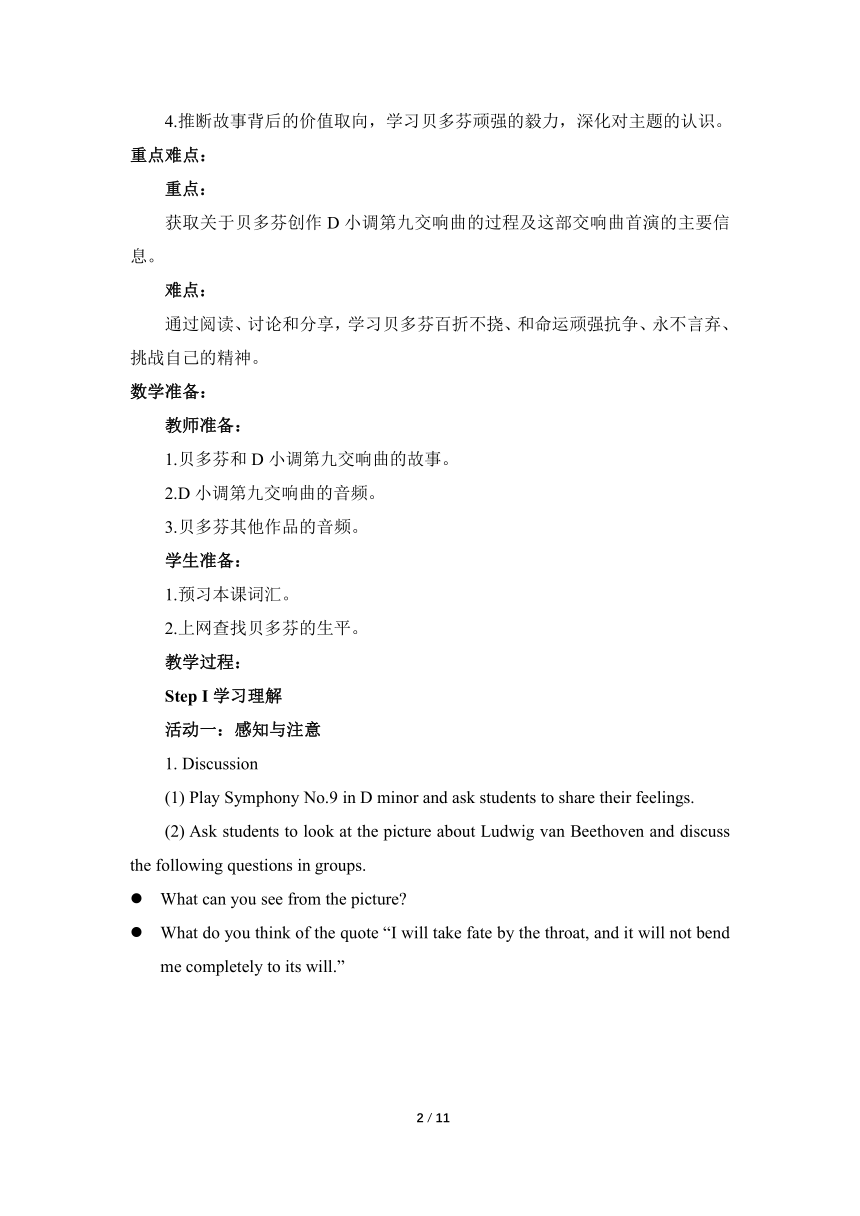
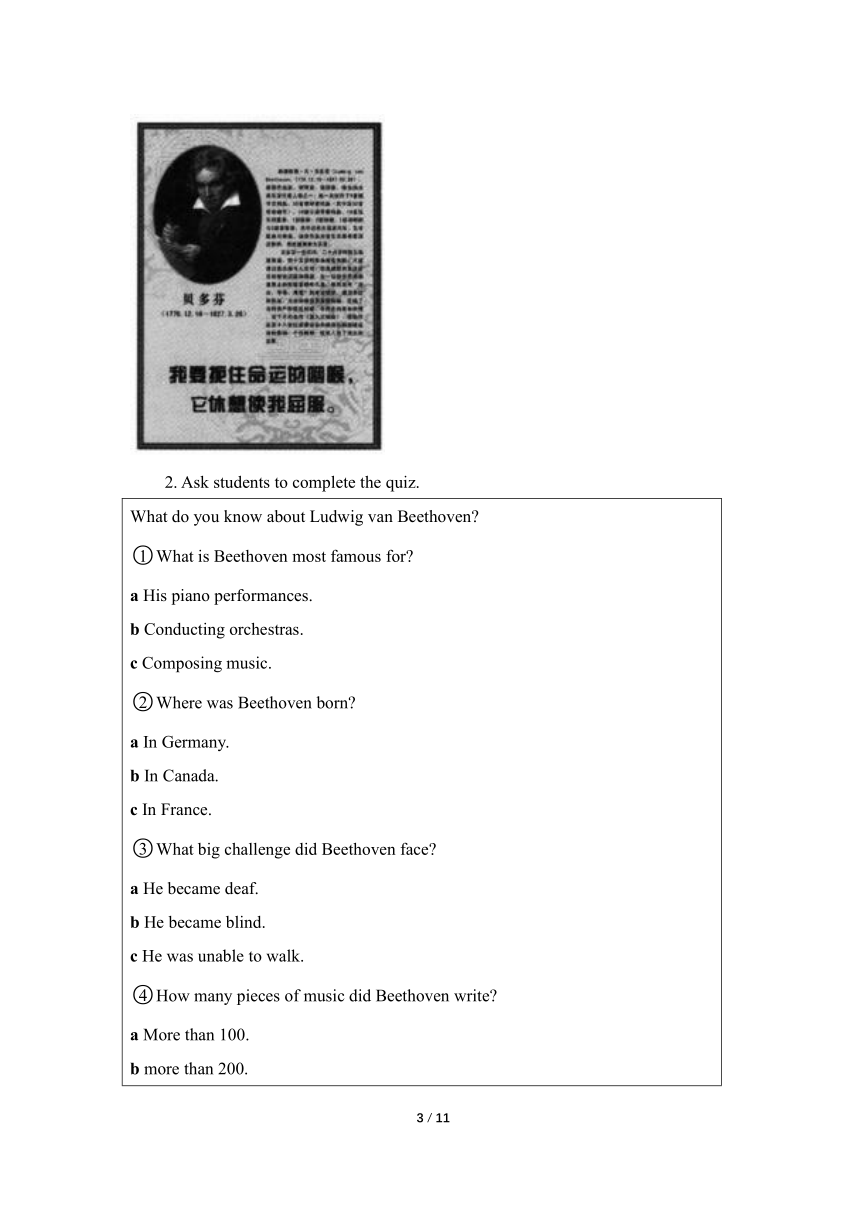
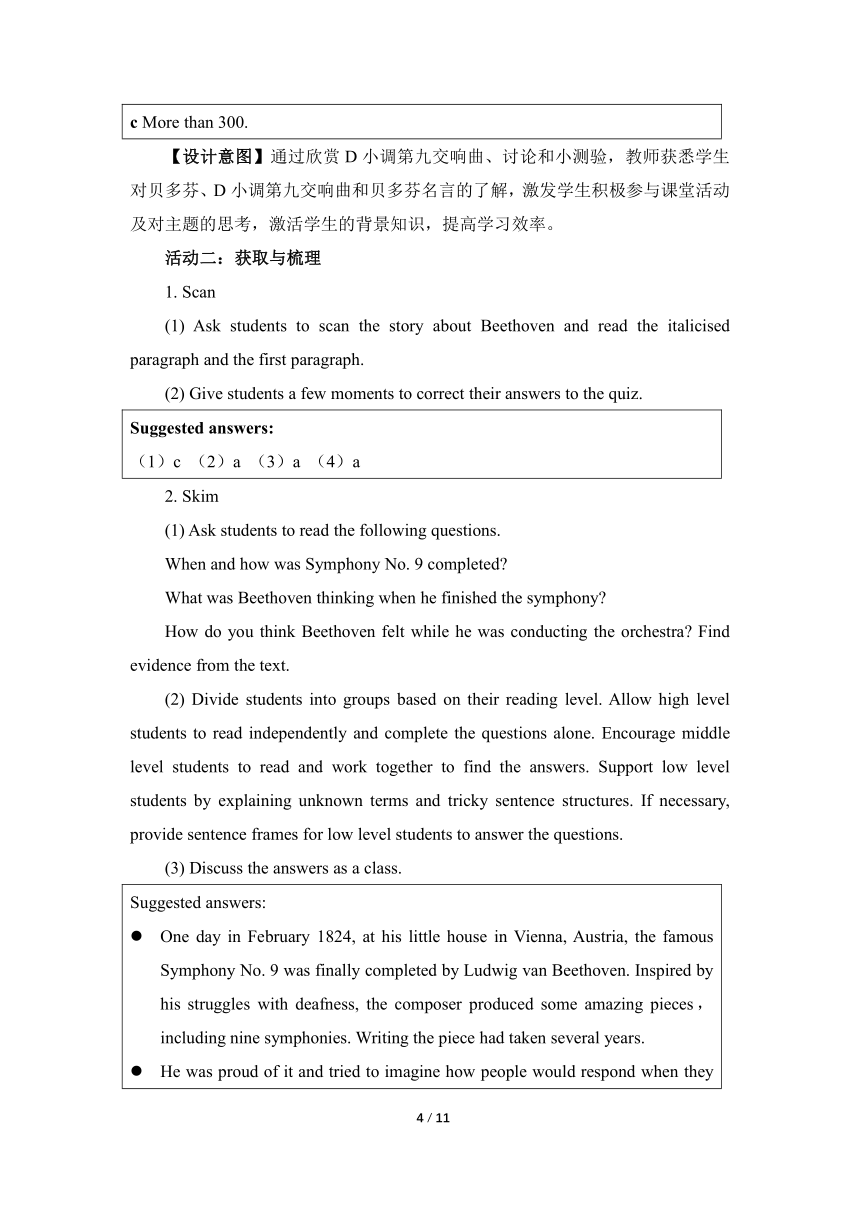
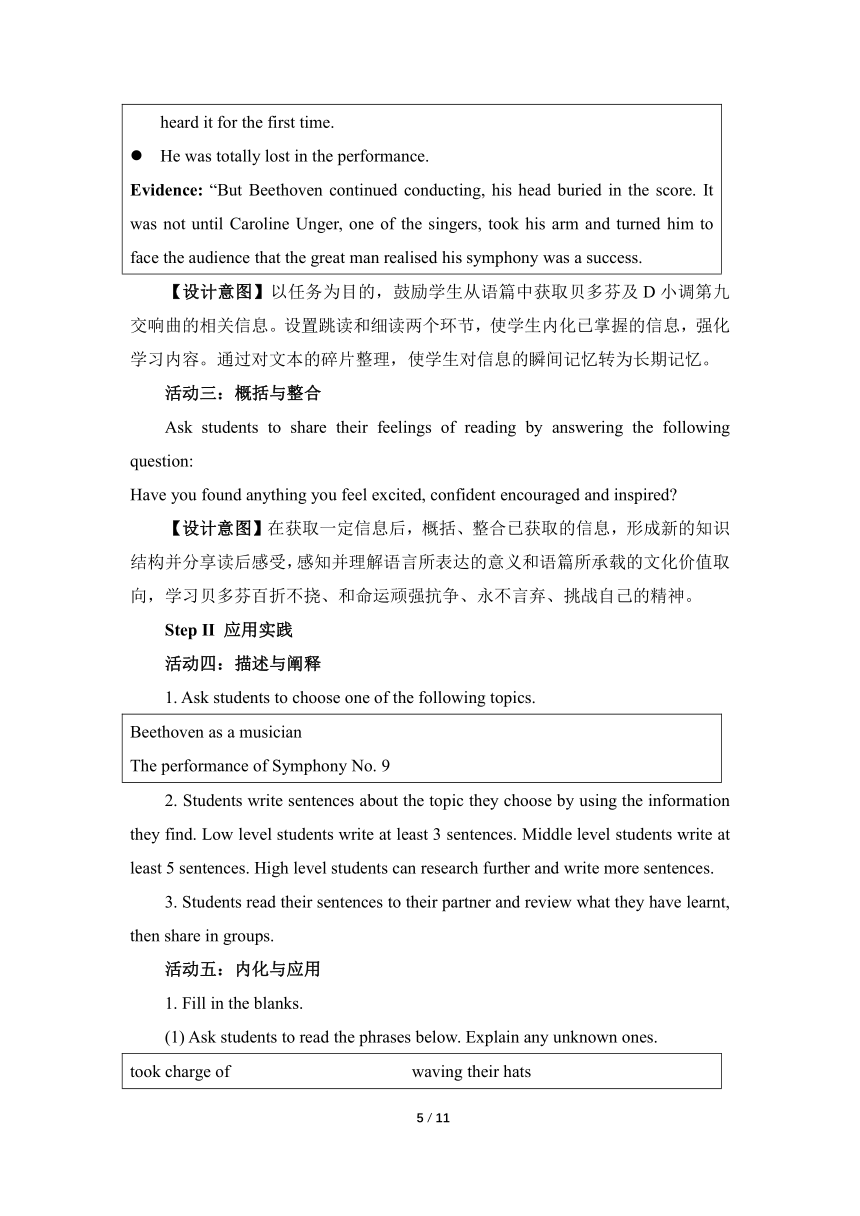
文档简介
Unit 7 Lesson 3 名师教学设计
课时内容:
A Musical genius
主题语境:人与社会
主题群:文学、艺术与体育
子主题:音乐等领域的概况及其发展
语篇类型:人物传记
文本分析:
[What]“A Musical genius”是一篇记叙文,讲述的是音乐天才贝多芬创作D小调第九交响曲的过程及这部交响曲首演的故事。贝多芬是德国作曲家,被认为是世界音乐史上最伟大的作曲家之一,一生共创作了130多部音乐作品,其中D小调第九交响曲是在贝多芬失聪的情况下耗时几年完成的。第九交响曲的首演是在维也纳一个非常著名的剧院里,这部交响曲取得了空前的成功。
[Why]通过阅读故事及补充的课外资料,使学生了解贝多芬一生坎坷,尤其是双耳失聪,这对于音乐家来说,是致命的打击,但是贝多芬没有接受命运的安排,他一生忍受着痛苦,不断地与自己苦难的命运作斗争,创造了一曲又一曲享誉世界的名曲。这些乐曲或雄壮、或欢快、或静逸、或优美,都是他对命运最有力的反抗。他的名言“我要扼住命运的咽喉,它休想使我屈服”,正是他对生活的态度,也是他一生的精神写照。从贝多芬身上,学生可以学习他与命运抗争的不屈精神。
[How]本文作者以时间顺序,从what,who,when where,why,how及用第三人称展开描述,直接把故事的情节展现在读者面前,文章的客观性很强。作者最后用直接引语代替间接引语的陈述,可以更客观、生动地反映他人对贝多芬的真实评价,使文章更加生动、具体。
课时目标:
1.获取、梳理贝多芬创作D小调第九交响曲的过程及这部交响曲首演的主要信息。
2.能用恰当的语言介绍贝多芬和D小调第九交响曲首演等细节。
3.学习和练习构词法。
4.推断故事背后的价值取向,学习贝多芬顽强的毅力,深化对主题的认识。
重点难点:
重点:
获取关于贝多芬创作D小调第九交响曲的过程及这部交响曲首演的主要信息。
难点:
通过阅读、讨论和分享,学习贝多芬百折不挠、和命运顽强抗争、永不言弃、挑战自己的精神。
数学准备:
教师准备:
1.贝多芬和D小调第九交响曲的故事。
2.D小调第九交响曲的音频。
3.贝多芬其他作品的音频。
学生准备:
1.预习本课词汇。
2.上网查找贝多芬的生平。
教学过程:
Step I学习理解
活动一:感知与注意
1. Discussion
(1) Play Symphony No.9 in D minor and ask students to share their feelings.
(2) Ask students to look at the picture about Ludwig van Beethoven and discuss the following questions in groups.
What can you see from the picture
What do you think of the quote “I will take fate by the throat, and it will not bend me completely to its will.”
2. Ask students to complete the quiz.
What do you know about Ludwig van Beethoven What is Beethoven most famous for a His piano performances. b Conducting orchestras. c Composing music. Where was Beethoven born a In Germany. b In Canada. c In France. What big challenge did Beethoven face a He became deaf. b He became blind. c He was unable to walk. How many pieces of music did Beethoven write a More than 100. b more than 200. c More than 300.
【设计意图】通过欣赏D小调第九交响曲、讨论和小测验,教师获悉学生对贝多芬、D小调第九交响曲和贝多芬名言的了解,激发学生积极参与课堂活动及对主题的思考,激活学生的背景知识,提高学习效率。
活动二:获取与梳理
1. Scan
(1) Ask students to scan the story about Beethoven and read the italicised paragraph and the first paragraph.
(2) Give students a few moments to correct their answers to the quiz.
Suggested answers: (1)c (2)a (3)a (4)a
2. Skim
(1) Ask students to read the following questions.
When and how was Symphony No. 9 completed
What was Beethoven thinking when he finished the symphony
How do you think Beethoven felt while he was conducting the orchestra Find evidence from the text.
(2) Divide students into groups based on their reading level. Allow high level students to read independently and complete the questions alone. Encourage middle level students to read and work together to find the answers. Support low level students by explaining unknown terms and tricky sentence structures. If necessary, provide sentence frames for low level students to answer the questions.
(3) Discuss the answers as a class.
Suggested answers: One day in February 1824, at his little house in Vienna, Austria, the famous Symphony No. 9 was finally completed by Ludwig van Beethoven. Inspired by his struggles with deafness, the composer produced some amazing pieces,including nine symphonies. Writing the piece had taken several years. He was proud of it and tried to imagine how people would respond when they heard it for the first time. He was totally lost in the performance. Evidence: “But Beethoven continued conducting, his head buried in the score. It was not until Caroline Unger, one of the singers, took his arm and turned him to face the audience that the great man realised his symphony was a success.
【设计意图】以任务为目的,鼓励学生从语篇中获取贝多芬及D小调第九交响曲的相关信息。设置跳读和细读两个环节,使学生内化已掌握的信息,强化学习内容。通过对文本的碎片整理,使学生对信息的瞬间记忆转为长期记忆。
活动三:概括与整合
Ask students to share their feelings of reading by answering the following question:
Have you found anything you feel excited, confident encouraged and inspired
【设计意图】在获取一定信息后,概括、整合已获取的信息,形成新的知识结构并分享读后感受,感知并理解语言所表达的意义和语篇所承载的文化价值取向,学习贝多芬百折不挠、和命运顽强抗争、永不言弃、挑战自己的精神。
Step Ⅱ 应用实践
活动四:描述与阐释
1. Ask students to choose one of the following topics.
Beethoven as a musician The performance of Symphony No. 9
2. Students write sentences about the topic they choose by using the information they find. Low level students write at least 3 sentences. Middle level students write at least 5 sentences. High level students can research further and write more sentences.
3. Students read their sentences to their partner and review what they have learnt, then share in groups.
活动五:内化与应用
1. Fill in the blanks.
(1) Ask students to read the phrases below. Explain any unknown ones.
took charge of waving their hats waving his arms wildly jumped about turned him to face backstage atmosphere madly turning the pages jumped to their feet with a broad smile
(2) Ask students to complete the sentences with the phrases above.
Before the performance, the ________ was tense. Michael Umlauf joined him and together the two men ________ the orchestra. Beethoven ________ in front of the orchestra, ________ in the air, and ________ of his score. As the final note signalled the end, the audience ________, clapping, cheering, and ________. Caroline Unger took Beethoven’s arm and ________ the audience. In an interview afterwards, Caroline said ________, “ The audience was shocked as well.”
Suggested answers: ①backstage atmosphere ②took charge of ③jumped about, waving his arms wildly, madly urning the pages ④jumped to their feet, waving their hats ⑤turned him to face ⑥with a broad smile
2. Focus on language: Word building.
(1) Instruct students to use their dictionaries to assist with completing the table.
Noun Verb Adjective
music musician ×
composition ×
performance ×
produce
× conduct ×
Hesitate
joy Enjoy
respond
(2) Ask students to look up one of the words in their dictionary, and find answers to the following questions.
What part of speech is it
What is the verb form
What is the adjective form
How did the word change
(3) Ask students to underline the suffixes that were added.
(4) Ask students to work independently or in a group.
(5) Ask students to discuss the answers as a class.
Noun Verb Adjective
music musician × musical
composition composer compose ×
performance performer perform ×
production producer produce
× conductor conduct ×
hesitation Hesitate hesitated
joy Enjoy joyous
response respond responsive
(6) Ask students to complete the sentences with the correct form of the words above.
It has always been my dream to ________ an orchestra. The musician ________ with nervousness before he began to play. Beethoven is recognised as a ________ genius by people around the world. Beethoven is the ________ of Symphony No.9 in D minor. To his mother’s ________, he won first prize. She told me about the wonderful ________ that she had been to last week. The audience’s ________ to the performance of the symphony was extraordinary. Though Beethoven lost his hearing, he ________ some amazing pieces of music.
Suggested answers: conduct hesitated musical composer joy performance response produced
【设计意图】在学习理解的基础上,引导学生通过练习掌握本课重要短语。通过探索单词的动词、名词、形容词形式及完成句子练习,达到掌握单词词性、灵活运用单词的目的,逐步实现对语言知识的内化,促进语言运用的自动化。
Step Ⅲ 迁移创新
活动六:推理与论证
Think and share.
(1) The description of Beethoven’s behaviour in the performance shows that he was deaf. Can you find the hints Why did most of the audience have no idea that he was deaf
(2) How did Caroline feel when she said “The one person in the room who didn’t hear the symphony—and never would—was the very man who composed it.”
Suggested answers: (1) “The whole time, Umlauf stood quietly by his side, skilfully guiding the orchestra.” The music ended but Beethoven continued to conduct. “It was not until Caroline Unger, one of the singers, took his arm and turned him to face the audience that the great man realised his symphony was a success.” The audience might think Beethoven was deeply lost in his own music. (2) She felt very very sorry that Beethoven couldn’t hear the music he composed, It was such a pity and she might feel it unfair for him. She must have wished Beethoven was not deaf.
【设计意图】通过该活动引导学生对故事中人物的态度进行推理和论证,探讨语篇与主题意义的关联,使学生能感受字里行间透露出的内在信息:对于音乐家最大的打击是失聪,贝多芬在这样的情形下仍与命运抗争,这种坚强的意志和顽强的毅力值得所有人敬佩。
活动七:想象与创造
1. Skill Builder.
(1) Ask students to read the rubric and the Skill Builder.
(2) Encourage students to find the information about the three topics below.
(3) Ask students to discuss and check the answers as a class.
Suggested answers: General information: last symphony written, he was afraid that it would be a disaster, musical director t was Michael Umlauf, audience were shocked that he was deaf Composing of Symphony No. 9: took several years, completed in Vienna Performance of Symphony No 9: For more than an hour, Beethoven jumped about in front of the orchestra, waving his arms wildly in the air, and madly turning the pages of his score. The whole time, Umlauf stood quietly by his side, skilfully guiding the orchestra through the most amazing piece of music the world had ever known.
(4) Add more information that is not mentioned in the story and share in the class.
2. Express yourself.
(1) Ask students to discuss which part of the story about Beethoven impressed them most and why. Students can share their answers in pairs or in groups.
(2) Find some pieces of Beethoven’s music online and play the pieces of Beethoven’s music. Ask students to discuss how they feel when listening to his music by answering the following questions.
How does the music make you feel
What does it remind you of
Do you like it?Why or why not
【设计意图】用“信息结构图”巩固已学知识,能有效地增进学生的学习能力和创造力,并帮助学生主动思考,增进表达与沟通能力。通过要求学生“谈论本课中最令人印象深刻的部分”和“听贝多芬的作品,并分享感受”两个活动,引导学生加深对主题意义的理解,提高综合运用语言的技能,理性表达自己的观点,学习贝多芬生命不息、创作不止的顽强精神。
板书设计:
Unit 7 Art Period Ⅳ Lesson 3 I.学习理解 活动一:感知与注意 1. Discussion 2. Complete the quiz 活动二:获取与梳理 1. Scan 2. Skim 活动三:概括与整合 Ⅱ.应用实践 活动四:描述与阐释 活动五:内化与应用 1. Fill in the blanks 2. Focus on language: Word building. Ⅲ.迁移创新 活动六:推理与论证 活动七:想象与创造 1. Skill builder 2. Express yourself
2 / 2
课时内容:
A Musical genius
主题语境:人与社会
主题群:文学、艺术与体育
子主题:音乐等领域的概况及其发展
语篇类型:人物传记
文本分析:
[What]“A Musical genius”是一篇记叙文,讲述的是音乐天才贝多芬创作D小调第九交响曲的过程及这部交响曲首演的故事。贝多芬是德国作曲家,被认为是世界音乐史上最伟大的作曲家之一,一生共创作了130多部音乐作品,其中D小调第九交响曲是在贝多芬失聪的情况下耗时几年完成的。第九交响曲的首演是在维也纳一个非常著名的剧院里,这部交响曲取得了空前的成功。
[Why]通过阅读故事及补充的课外资料,使学生了解贝多芬一生坎坷,尤其是双耳失聪,这对于音乐家来说,是致命的打击,但是贝多芬没有接受命运的安排,他一生忍受着痛苦,不断地与自己苦难的命运作斗争,创造了一曲又一曲享誉世界的名曲。这些乐曲或雄壮、或欢快、或静逸、或优美,都是他对命运最有力的反抗。他的名言“我要扼住命运的咽喉,它休想使我屈服”,正是他对生活的态度,也是他一生的精神写照。从贝多芬身上,学生可以学习他与命运抗争的不屈精神。
[How]本文作者以时间顺序,从what,who,when where,why,how及用第三人称展开描述,直接把故事的情节展现在读者面前,文章的客观性很强。作者最后用直接引语代替间接引语的陈述,可以更客观、生动地反映他人对贝多芬的真实评价,使文章更加生动、具体。
课时目标:
1.获取、梳理贝多芬创作D小调第九交响曲的过程及这部交响曲首演的主要信息。
2.能用恰当的语言介绍贝多芬和D小调第九交响曲首演等细节。
3.学习和练习构词法。
4.推断故事背后的价值取向,学习贝多芬顽强的毅力,深化对主题的认识。
重点难点:
重点:
获取关于贝多芬创作D小调第九交响曲的过程及这部交响曲首演的主要信息。
难点:
通过阅读、讨论和分享,学习贝多芬百折不挠、和命运顽强抗争、永不言弃、挑战自己的精神。
数学准备:
教师准备:
1.贝多芬和D小调第九交响曲的故事。
2.D小调第九交响曲的音频。
3.贝多芬其他作品的音频。
学生准备:
1.预习本课词汇。
2.上网查找贝多芬的生平。
教学过程:
Step I学习理解
活动一:感知与注意
1. Discussion
(1) Play Symphony No.9 in D minor and ask students to share their feelings.
(2) Ask students to look at the picture about Ludwig van Beethoven and discuss the following questions in groups.
What can you see from the picture
What do you think of the quote “I will take fate by the throat, and it will not bend me completely to its will.”
2. Ask students to complete the quiz.
What do you know about Ludwig van Beethoven What is Beethoven most famous for a His piano performances. b Conducting orchestras. c Composing music. Where was Beethoven born a In Germany. b In Canada. c In France. What big challenge did Beethoven face a He became deaf. b He became blind. c He was unable to walk. How many pieces of music did Beethoven write a More than 100. b more than 200. c More than 300.
【设计意图】通过欣赏D小调第九交响曲、讨论和小测验,教师获悉学生对贝多芬、D小调第九交响曲和贝多芬名言的了解,激发学生积极参与课堂活动及对主题的思考,激活学生的背景知识,提高学习效率。
活动二:获取与梳理
1. Scan
(1) Ask students to scan the story about Beethoven and read the italicised paragraph and the first paragraph.
(2) Give students a few moments to correct their answers to the quiz.
Suggested answers: (1)c (2)a (3)a (4)a
2. Skim
(1) Ask students to read the following questions.
When and how was Symphony No. 9 completed
What was Beethoven thinking when he finished the symphony
How do you think Beethoven felt while he was conducting the orchestra Find evidence from the text.
(2) Divide students into groups based on their reading level. Allow high level students to read independently and complete the questions alone. Encourage middle level students to read and work together to find the answers. Support low level students by explaining unknown terms and tricky sentence structures. If necessary, provide sentence frames for low level students to answer the questions.
(3) Discuss the answers as a class.
Suggested answers: One day in February 1824, at his little house in Vienna, Austria, the famous Symphony No. 9 was finally completed by Ludwig van Beethoven. Inspired by his struggles with deafness, the composer produced some amazing pieces,including nine symphonies. Writing the piece had taken several years. He was proud of it and tried to imagine how people would respond when they heard it for the first time. He was totally lost in the performance. Evidence: “But Beethoven continued conducting, his head buried in the score. It was not until Caroline Unger, one of the singers, took his arm and turned him to face the audience that the great man realised his symphony was a success.
【设计意图】以任务为目的,鼓励学生从语篇中获取贝多芬及D小调第九交响曲的相关信息。设置跳读和细读两个环节,使学生内化已掌握的信息,强化学习内容。通过对文本的碎片整理,使学生对信息的瞬间记忆转为长期记忆。
活动三:概括与整合
Ask students to share their feelings of reading by answering the following question:
Have you found anything you feel excited, confident encouraged and inspired
【设计意图】在获取一定信息后,概括、整合已获取的信息,形成新的知识结构并分享读后感受,感知并理解语言所表达的意义和语篇所承载的文化价值取向,学习贝多芬百折不挠、和命运顽强抗争、永不言弃、挑战自己的精神。
Step Ⅱ 应用实践
活动四:描述与阐释
1. Ask students to choose one of the following topics.
Beethoven as a musician The performance of Symphony No. 9
2. Students write sentences about the topic they choose by using the information they find. Low level students write at least 3 sentences. Middle level students write at least 5 sentences. High level students can research further and write more sentences.
3. Students read their sentences to their partner and review what they have learnt, then share in groups.
活动五:内化与应用
1. Fill in the blanks.
(1) Ask students to read the phrases below. Explain any unknown ones.
took charge of waving their hats waving his arms wildly jumped about turned him to face backstage atmosphere madly turning the pages jumped to their feet with a broad smile
(2) Ask students to complete the sentences with the phrases above.
Before the performance, the ________ was tense. Michael Umlauf joined him and together the two men ________ the orchestra. Beethoven ________ in front of the orchestra, ________ in the air, and ________ of his score. As the final note signalled the end, the audience ________, clapping, cheering, and ________. Caroline Unger took Beethoven’s arm and ________ the audience. In an interview afterwards, Caroline said ________, “ The audience was shocked as well.”
Suggested answers: ①backstage atmosphere ②took charge of ③jumped about, waving his arms wildly, madly urning the pages ④jumped to their feet, waving their hats ⑤turned him to face ⑥with a broad smile
2. Focus on language: Word building.
(1) Instruct students to use their dictionaries to assist with completing the table.
Noun Verb Adjective
music musician ×
composition ×
performance ×
produce
× conduct ×
Hesitate
joy Enjoy
respond
(2) Ask students to look up one of the words in their dictionary, and find answers to the following questions.
What part of speech is it
What is the verb form
What is the adjective form
How did the word change
(3) Ask students to underline the suffixes that were added.
(4) Ask students to work independently or in a group.
(5) Ask students to discuss the answers as a class.
Noun Verb Adjective
music musician × musical
composition composer compose ×
performance performer perform ×
production producer produce
× conductor conduct ×
hesitation Hesitate hesitated
joy Enjoy joyous
response respond responsive
(6) Ask students to complete the sentences with the correct form of the words above.
It has always been my dream to ________ an orchestra. The musician ________ with nervousness before he began to play. Beethoven is recognised as a ________ genius by people around the world. Beethoven is the ________ of Symphony No.9 in D minor. To his mother’s ________, he won first prize. She told me about the wonderful ________ that she had been to last week. The audience’s ________ to the performance of the symphony was extraordinary. Though Beethoven lost his hearing, he ________ some amazing pieces of music.
Suggested answers: conduct hesitated musical composer joy performance response produced
【设计意图】在学习理解的基础上,引导学生通过练习掌握本课重要短语。通过探索单词的动词、名词、形容词形式及完成句子练习,达到掌握单词词性、灵活运用单词的目的,逐步实现对语言知识的内化,促进语言运用的自动化。
Step Ⅲ 迁移创新
活动六:推理与论证
Think and share.
(1) The description of Beethoven’s behaviour in the performance shows that he was deaf. Can you find the hints Why did most of the audience have no idea that he was deaf
(2) How did Caroline feel when she said “The one person in the room who didn’t hear the symphony—and never would—was the very man who composed it.”
Suggested answers: (1) “The whole time, Umlauf stood quietly by his side, skilfully guiding the orchestra.” The music ended but Beethoven continued to conduct. “It was not until Caroline Unger, one of the singers, took his arm and turned him to face the audience that the great man realised his symphony was a success.” The audience might think Beethoven was deeply lost in his own music. (2) She felt very very sorry that Beethoven couldn’t hear the music he composed, It was such a pity and she might feel it unfair for him. She must have wished Beethoven was not deaf.
【设计意图】通过该活动引导学生对故事中人物的态度进行推理和论证,探讨语篇与主题意义的关联,使学生能感受字里行间透露出的内在信息:对于音乐家最大的打击是失聪,贝多芬在这样的情形下仍与命运抗争,这种坚强的意志和顽强的毅力值得所有人敬佩。
活动七:想象与创造
1. Skill Builder.
(1) Ask students to read the rubric and the Skill Builder.
(2) Encourage students to find the information about the three topics below.
(3) Ask students to discuss and check the answers as a class.
Suggested answers: General information: last symphony written, he was afraid that it would be a disaster, musical director t was Michael Umlauf, audience were shocked that he was deaf Composing of Symphony No. 9: took several years, completed in Vienna Performance of Symphony No 9: For more than an hour, Beethoven jumped about in front of the orchestra, waving his arms wildly in the air, and madly turning the pages of his score. The whole time, Umlauf stood quietly by his side, skilfully guiding the orchestra through the most amazing piece of music the world had ever known.
(4) Add more information that is not mentioned in the story and share in the class.
2. Express yourself.
(1) Ask students to discuss which part of the story about Beethoven impressed them most and why. Students can share their answers in pairs or in groups.
(2) Find some pieces of Beethoven’s music online and play the pieces of Beethoven’s music. Ask students to discuss how they feel when listening to his music by answering the following questions.
How does the music make you feel
What does it remind you of
Do you like it?Why or why not
【设计意图】用“信息结构图”巩固已学知识,能有效地增进学生的学习能力和创造力,并帮助学生主动思考,增进表达与沟通能力。通过要求学生“谈论本课中最令人印象深刻的部分”和“听贝多芬的作品,并分享感受”两个活动,引导学生加深对主题意义的理解,提高综合运用语言的技能,理性表达自己的观点,学习贝多芬生命不息、创作不止的顽强精神。
板书设计:
Unit 7 Art Period Ⅳ Lesson 3 I.学习理解 活动一:感知与注意 1. Discussion 2. Complete the quiz 活动二:获取与梳理 1. Scan 2. Skim 活动三:概括与整合 Ⅱ.应用实践 活动四:描述与阐释 活动五:内化与应用 1. Fill in the blanks 2. Focus on language: Word building. Ⅲ.迁移创新 活动六:推理与论证 活动七:想象与创造 1. Skill builder 2. Express yourself
2 / 2
同课章节目录
- Unit 7 Art
- Lesson 1 Masterpieces
- Lesson 2 Beijing Opera
- Lesson 3 A Musical Genius
- Unit 8 Green living
- Lesson 1 Roots and Shoots
- Lesson 2 Greening the Desert
- Lesson 3 "White Bikes" on the Road
- Unit 9 Learning
- Lesson 1 Active Learning
- Lesson 2 Language Learning Tips
- Lesson 3 The Secrets of Your Memory
